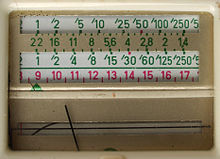APEX (photography)
The APEX system (English Additive System of Photographic Exposure ; German: Additive system for photographic exposure ) represents the essential values in photographic exposure as small whole numbers, mostly in the range 0 to 10. The system is logarithmic and thus enables it to determine desired exposure values through simple additions and subtractions.
Example: If the APEX value for the exposure time is increased by 1 (which means halving the exposure time), the APEX value for the f-number must be decreased by 1 in order to obtain the same exposure under otherwise identical conditions.
The method was presented within the framework of the standards ASA PH2.5-1960 , ASA PH2.12-1961 and ANSI PH3.49-1971 .
The APEX values
Aperture value Av
The aperture value Av (English aperture value ) is zero for the aperture ratio f / 1 and increases with each aperture stop by exactly 1, while the F-number in each stage with 1.4 (more precisely ) is multiplied.
| F-number | 1 | 1.4 | 2 | 2.8 | 4th | 5.6 | 8th | 11 | 16 | 22nd | 32 |
|---|---|---|---|---|---|---|---|---|---|---|---|
| Aperture value Av | 0 | 1 | 2 | 3 | 4th | 5 | 6th | 7th | 8th | 9 | 10 |
Time value Tv
The value Tv (English time value ) is zero for an exposure time of 1 second and increases with each halving of order. 1 The table shows the rounded shutter speeds customary in photography, which are not exactly halved.
| Exposure time (s) | 1 | 1 ⁄ 2 | 1 ⁄ 4 | 1 ⁄ 8 | 1 ⁄ 15 | 1 ⁄ 30 | 1 ⁄ 60 | 1 ⁄ 125 | 1 ⁄ 250 | 1 ⁄ 500 | 1 ⁄ 1000 |
|---|---|---|---|---|---|---|---|---|---|---|---|
| Time value Tv | 0 | 1 | 2 | 3 | 4th | 5 | 6th | 7th | 8th | 9 | 10 |
Light value Ev
The sum of the aperture value and time value gives the light value Ev ( exposure value ):
- Ev = Av + Tv
The higher the light value, the lower the “amount of light” that reaches the image receiver during the exposure.
Sensitivity value Sv
The sensitivity value Sv (English speed value ) is zero for a film / sensor sensitivity of 3 ISO (exactly: 3.125) and increases by 1 with every doubling.
| Sensitivity (ISO) | 3 | 6th | 12 | 25th | 50 | 100 | 200 | 400 | 800 | 1600 | 3200 |
|---|---|---|---|---|---|---|---|---|---|---|---|
| Sensitivity value Sv | 0 | 1 | 2 | 3 | 4th | 5 | 6th | 7th | 8th | 9 | 10 |
Brightness value Bv
The brightness value Bv (English brightnessvalue ) is the luminance from the photographed area and follows the historic unit footlambert . It is zero for 1 footlambert and increases by 1 with every doubling.
| Luminance (ft.la.) | 1 | 2 | 4th | 8th | 16 | 32 | 64 | 128 | 256 | 512 | 1024 |
|---|---|---|---|---|---|---|---|---|---|---|---|
| Brightness value Bv | 0 | 1 | 2 | 3 | 4th | 5 | 6th | 7th | 8th | 9 | 10 |
Expansion of the scales
The APEX values can be continued up or down (into the negative range) as desired, whereby a difference in the APEX value of 1 represents a doubling / halving (except for the f-number) of the physical value. A sensitivity of 12800 ISO corresponds to Sv = 12, an exposure time of 8 s corresponds to Tv = −3, an aperture of 0.7 corresponds to Av = −1.
application
The equation applies to correct exposure
- Av + Tv = Bv + Sv
The mutual dependencies of the exposure parameters are reduced to the simplest addition and subtraction.
In order to selectively under or over exposure, the correction value Cv can be included in the equation:
- Av + Tv + Cv = Bv + Sv
For Cv = 1 there is overexposure by 1 Ev, which corresponds to 1 f-stop.
meaning
Despite its simplicity, the APEX system has not been able to assert itself as far as the settings of photographic cameras - there the (rounded) physical values for exposure time and f-number are usually used. On the other hand, the Munich precision mechanics manufacturer Friedrich Deckel designed camera shutters as early as the 1950s that had to be set according to a similar system called LVS (light value scale).
A lot of work is done with the light value Ev in professional exposure measurement. It also serves as a pseudo-unit for setting the exposure compensation in automatic cameras.
literature
- English tutorial by Douglas A. Kerr (PDF file; 153 kB)

